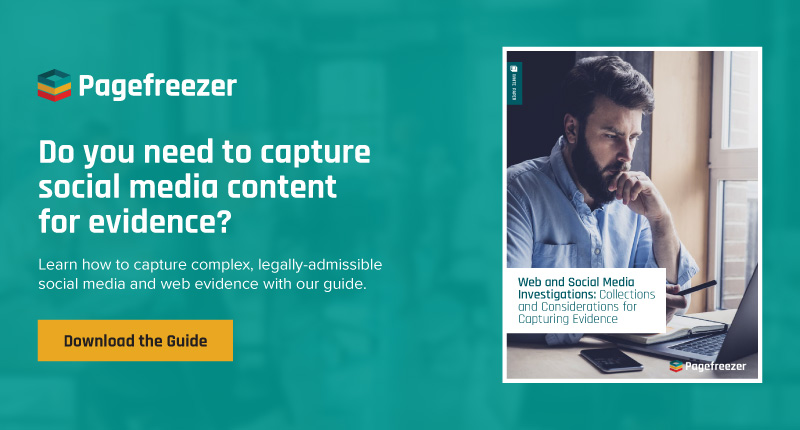These days, nearly every litigation matter involves social media evidence. If your case does not feature such important evidence, it is likely because you are not looking for it.
By analogy, Taylor Swift’s music is all around us, but you won’t hear it unless you tune into it on the radio or your streaming music site of choice.
Similarly, you have put some effort to tune into the torrential rivers of social media evidence.
Researching Social Media Evidence Trends in Litigation
To illustrate this point, we sought to identify some metrics reflecting the ubiquity of social media evidence in litigation matters. While this is an inexact science, we searched online legal databases of state and federal court decisions across the United States to identify the number of cases from the past twelve months where evidence from social networking sites played a significant role.
The search was limited to five social networking sites: Facebook, LinkedIn, X/Twitter, Instagram, YouTube and TikTok for the period September 1, 2022, through August 31, 2023.
The preliminary result was 5,623 cases.
However, according to UCLA Law, less than 1% of litigation matters result or otherwise generate a published opinion, noting that:
“...less than half of intermediate appellate opinions tend to be published. State trial court opinions are never published, and only a tiny fraction of federal trial (district) court opinions are published.”
By extrapolating the percentages, we can very conservatively estimated that the 5,623 cases represented 1% of all cases involving social media evidence, bringing the actual estimated number to 562,300.
We then employed a sampling method to determine that about 10% of the results were merely situations where the social media company was a named party or de minimis mentions — defined as cases with merely cursory or passing mentions of social media, so we pared down the results to an even half million.
This survey is an important data point establishing the ubiquitous nature of social media evidence and the importance of best practices technology like X1 Social Discovery and WebPreserver to “tune in” to this evidence by searching and collecting social media evidence for litigation and compliance requirements.
The Rise of Social Media Evidence in Litigation
In a panel discussion on social media evidence for Law Practice Today, Samantha V. Ettari (SE), an e-discovery counsel at Kramer Levin Naftalis & Frankel discussed the recent rise of social media evidence in litigation:
"Social media is a fantastic tool for discovering potential evidence for an affirmative case or defense—like any other form of evidence, social media platforms should not be overlooked as a potential source of information. In the formal discovery process, it should be routine practice to include a request for the search and review of social media platforms in discovery requests if the underlying subject matter of the dispute provides a good-faith basis for belief that there is social media evidence relevant to the litigation."
She warns that individual privacy settings on social media accounts won't prevent those accounts or posts from being introduced as evidence:
"Many courts across the country are allowing discovery of social media, regardless of privacy settings. If you put something out there on a social media platform and it is responsive to discovery and relevant to the litigation, it will likely be ordered produced."
How Can Social Media Evidence Be Used in Litigation?
In the same panel discussion on social media evidence for Law Practice Today, Erik S. Syverson (ES), a well-known cyber liability litigator at Raines Feldman, LLP illuminates the many different ways he's personally used social media evidence in litigation:
"We use social media for any kind of information you can think of. We can use it to pick jurors on voir dire or get them excused for cause. We can use it to locate and serve difficult to find parties and witnesses. I have used it at trial to prove that someone was not where they claimed to be at the time of a tort. It won the case for us."
We've also seen many more examples, including:
- Using posts from the social media platform Strava to prove insurance fraud.
- Using a selfie posted on Facebook to find a murder weapon.
- Using self-incriminating posts in addition to video evidence to convict January 6 Capitol rioters.
- Using Reddit to help identify an obscure auto part and narrow the investigation in a hit and run.
- Using tagged photos on social media to contradict or conflict with a plaintiff's claims.
- Using bystander YouTube footage of reckless driving to prove car insurance fraud.
Is Social Media Evidence Admissible in Court?
Yes, social media evidence is admissible in court. But not all social media evidence is admissible. There have been many instances where social media evidence has been denied in court, including:
- Lack of sufficient metadata to prove ownership of the social media account.
- Lack of authentication to prove the social media posts are real, not altered or photoshopped.
- Evidence submitted as screen captures or print outs, instead of authenticated evidence.
All of these instances fail under the Federal Rules of Evidence - FRE rule 901(a) — which requires that Electronically Stored Information (ESI) like social media content must be authenticated.
For social media evidence to be accepted as authentic, it must include:
-
Original source code of the social media message, post, or account
-
Digital signatures and timestamps
-
EDRM-XML formatting for easy processing & analysis in eDiscovery systems
These measures also can help prove the ownership of a particular social media account by linking the metadata like IP address to the user.
All that said, introducing social media content as evidence in litigation can be complex and demands thorough authentication.
However, if you can authenticate your records, Erik S. Syverson (ES), says: "Admissibility is the only limit on the usefulness of social media... Judges are increasingly comfortable with admitting social media evidence."
How To Collect Authenticated Social Media Evidence
To collect social media evidence that can be used successfully in litigation and meets all the requirements of FRE rule 901, you need the right tools.
When you use Pagefreezer's X1 Social Discovery or WebPreserver tools you can easily collect social media evidence from a variety of modern social media sources like TikTok, Facebook, X/Twitter, Instagram, Reddit and more. With just a few clicks, you can capture entire timelines, automatically expand and capture comments, and rest easy knowing all evidence collected will include the required metadata to prove its authenticity.
Ready to learn more? Download our social media evidence collection guide below.
Additional Resources
- How to Use Social Media in Fraud Investigations
- Capturing Website & Social Media Metadata
- Reference Guide: Collecting Authenticated Digital Evidence
Editor's Note: A version of this blog post originally appeared on the X1 Social Discovery blog. It has been updated and expanded for Pagefreezer after acquiring X1 Social Discovery.









